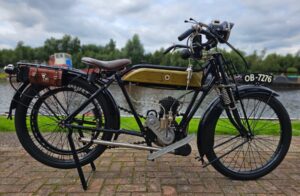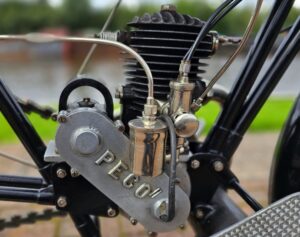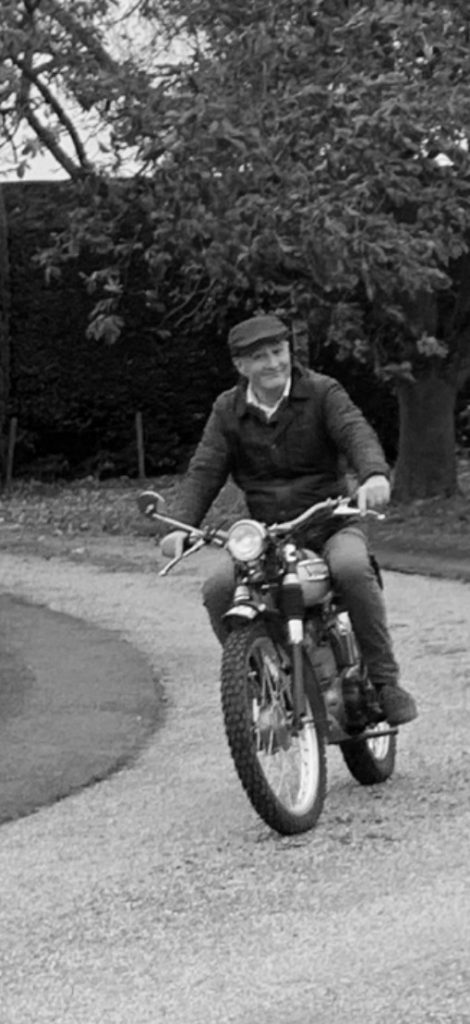Peco 2-stroke veteran, or vintage, motorcycle engines were supplied to many motorcycle manufacturers. Peco also produced their own motorcycles around 1914 to 1916.
Pearson and Cole of Duddeston Mill Road, Birmingham, UK, known as Peco, made their own motorcycles at some point between 1914 and 1916. While they made their own motorcycles, they were prolific two-stroke engine suppliers to many British motorcycle manufacturers.

Peco engine in a Trump veteran motorcycle
It is unclear when Peco precisely began production of engines, or their own motorcycles. The earliest record that I currently have of a Peco motorcycle is on the VMCC register with the year 1913.
In 1914, they advertised a Dunkley Two-Stroke 349cc, 2¾ h.p. engine, with 75 x 79mm bore and stroke. Having read some of the literature that Peco published towards the end of 1914, they were increasing the choice of engines by adding a 2¼ h.p. 2-stroke engine with a smaller 210 cc capacity. The piston shape was altered and the cases were narrower than before.
Peco had a write-up in The Motor cycle, Oct 29th 1914, regarding their announcement of the new 210 cc engine being ready for 1915. I’ve read the announcement several times and have come to the conclusion that there was a typo in the first sentence. They refer to the existing 2¼ h.p. engine, when I think they mean the 2¾ h.p.
Here is the article in full:
A NEW PECO ENGINE.
As the present 2¼ h.p. Peco two-stroke has proved so satisfactory there is 110 reason for alteration for the 1915 season However, the large demand for a somewhat smaller power plant has induced the firm to construct an engine of 62×69 mm. bore and stroke, which is rated at 2¼ h.p., and has a cubic capacity of 210 c.c.
Almost every feature of the larger engine is reproduced in the new type. To begin with, an improved type of Hoffmann roller big end is used which is considerably narrower over all, in spite of the fact that the roller surface remains as before. This permits of a narrower crank case and consequently higher crank case compression, so that it has been found that the double or false top to the piston, which is so noticeable a feature of the larger engine, can be dispensed with. The small engine also has a plain piston trunk with two pegged rings at the top, and plain mainshaft bearings are employed instead of rollers.
The patented lubrication system is, of course, retained, the oil being led to a ring surrounding the cylinder and passing through holes to the piston, then the surplus is caught by a well below the base of the piston and conducted by separate leads to each main crankshaft bearing.
The new engine is neat and light, and can be supplied for either belt or chain drive; in the latter case a dished flywheel can be fitted which allows the sprocket to be mounted on the outside instead of between the engine and flywheel; consequently chain guarding is rendered a much simpler problem, and the chain is more acessible.
The Motor Cycle, October 29th, 1914. p483
Calthorpe motorcycles – a major customer
Calthorpe veteran, and vintage, lightweight motorcycles were closely tied with Peco engines. My own 1915 Calthorpe had a JAP 2-stroke, but I am advised that Calthorpe were listed as having Peco engines in 1915 as well. I believe they used a 2.5 HP (67 x 69) 2-stroke 245cc 3-port type. In fact, they went on to produce larger capacity engines in the early 1920’s.
Calthorpe used Peco engines from 1915 right up until 1923. As Peco’s major customer, they took control of the company in 1919 and made some changes to the engine numbers, as can be seen in the table later on.
Here are some of the Calthorpe motorcycles that used Peco engines:
1915 “Calthorpe 2 Stroke – 2 Speed” – Peco 2 1/4 H.P, 63 m.m. bore x 69 m.m. stroke having a capacity of 214 c.c. Two stroke, of the 3-port type. Countershaft combination chain and belt drive)
1915 “Calthorpe 2 Stroke” – Peco 2 1/2 H.P, 67 m.m. bore x 69 m.m. stroke having a capacity of 245 c.c. Two stroke, of the 3-port type. Belt drive. (no chain sprocket outside the flywheel)
1916 2 ¼ h.p. “Calthorpe Two-Stroke” – Peco engine, but now branded Calthorpe. 2 ¼ h.p., 67 mm. bore x 69 mm. stroke having a capacity of 245 c.c. Two stroke of the three port type.
1916 2 ¼ h.p. “Calthorpe Ladies” – Peco engine, but now branded Calthorpe. 2 ¼ h.p., 67 mm. bore x 69 mm. stroke having a capacity of 245 c.c., Two stroke of the three port type.
1919 Calthorpe appear to have only used Precision and JAP engines in their two models. Presumably this was while they negotiated to take over Peco.
1920 2 ¾ h.p. “Calthorpe Two-Stroke” – Peco engine, but now branded Calthorpe. 2 ¾ h.p. PECO, 75 mm. bore x 79 mm. stroke having a capacity of 350 c.c. Two stroke of the three port type. Hoffman roller main bearings and crank pin.
1921 3 h.p. “Calthorpe Two-Stroke” – Peco engine, but now branded Calthorpe. 3 h.p. PECO, 75 mm. bore x 79 mm. stroke having a capacity of 350 c.c. Two stroke of the three port type. Hoffman roller main bearings and crank pin.
1921 3 h.p. “Calthorpe Combination” – Peco engine, but now branded Calthorpe. 3 h.p. PECO, 75 mm. bore x 79 mm. stroke having a capacity of 350 c.c. Two stroke of the three port type. Hoffman roller main bearings and crank pin.
1922 2 ½ h.p. “Calthorpe Two-Stroke” Single-Speed -Peco engine, but now branded Calthorpe.2 ½ h.p. PECO, 67mm. bore x 69mm. stroke having a capacity of 243c.c. Two stroke of the three port type. Hoffman roller main bearings and crank pin.
1922 2 ½ h.p. “Calthorpe Two-Stroke Two-Speed” – Peco engine, but now branded Calthorpe. 2 ½ h.p. PECO, 67mm. bore x 69mm. stroke having a capacity of 243c.c. Two stroke of the three port type. Hoffman roller main bearings and crank pin.
1922 3 h.p. “Calthorpe Two-Stroke Two-Speed” -Peco engine, but now branded Calthorpe. 3 h.p. PECO, 75 mm. bore x 79 mm. stroke having a capacity of 350 c.c. Two stroke of the three port type. Hoffman roller main bearings and crank pin.
1922 3 h.p. “Lightweight Combination“- Peco engine, but now branded Calthorpe. 3 h.p. PECO, 75 mm. bore x 79 mm. stroke having a capacity of 350 c.c. Two stroke of the three port type. Hoffman roller main bearings and crank pin.
1923 2 ½ h.p. “Calthorpe Two-Stroke” Single-Speed -Peco engine, but now branded Calthorpe. 2 ½ h.p. PECO, 67mm. bore x 69mm. stroke having a capacity of 243c.c. Two stroke of the three port type. Heavy Phosphor Bronze Bearings of large dimensions. Roller bearing to big end of connecting rod.
1923 2 ½ h.p. “Calthorpe Two-Stroke Two-Speed” -Peco engine, but now branded Calthorpe. 2 ½ h.p. PECO, 67mm. bore x 69mm. stroke having a capacity of 243c.c. Two stroke of the three port type. Heavy Phosphor Bronze Bearings of large dimensions. Roller bearing to big end of connecting rod.
1923 3 h.p. “Calthorpe-Combination” – Peco engine, but now branded Calthorpe. 3 h.p. PECO, 75mm. bore x 79mm. stroke having a capacity of 350c.c. Two stroke of the three port type. Heavy Phosphor Bronze Bearings of large dimensions. Roller bearing to big end of connecting rod.
In 1924, there are two Calthorpe models recorded as being produced with Peco engines. However, information is limited, so I have not listed them here.
List of motorcycle manufacturers known to have used Peco engines.
Following is a list of vintage and veteran motorcycle manufacturers that used Peco 2-stroke engines:
- Wolf (1915, Wolf Model B was fitted with the Peco 2¼ h.p. engine)
- Waverley (1921 The company listed a trio of 269cc two-strokes with Peco engines. 1922/3 There was one two-stroke, the 348cc two-stroke model.)
- Trump (1914-on and stated in a Trump press release in 1914)
- Singer (Late 1914 , first use of a two-stroke, two-speed, chain-cum-belt driven model, built under Peco licence. Short lived as Singer ceased motorcycle production in 1915)
- Ixion (1915 supplied a motorcycle with a 349cc Peco engine)
- Lily (1914 / 1915 Lily used a mix of engines including Peco)
- Ivy (It’s possible that Calthorpe supplied the 2 ½ HP (224 cc) and 3 HP ( 348 cc) engines in 1923)
- Grandex (1915 A 225cc Peco two-stroke model with two-speeds was added)
- Ernest Smith & Woodhouse (Regal Motorcycles. 1914 Regal-Peco with a 349cc two-stroke engine. 1915 349cc Peco joined by a 225cc two-stroke Peco)
- Endrick
- Edmund (1916 2 ¾ h.p. Peco engine in one of two models in the range)
- Dunkley (1914 The range mainly featured Precision engines, but listed one 349cc 2-Stroke, a Peco. 1915 all models used the Peco 349cc engine. 1916 Dunkley moved to JAP engines))
- Dreng & Co (Made the Despatch Rider lightweight motorcycle. 1915-1917, the Dreng machine had a 210cc Peco or 269cc Villiers two-stroke engine)
- Calthorpe (1915-on. Then Calthorpe took control of Peco in 1919)
- Alfred Wiseman (Built Sirrah, Macklum, Verus & Weaver motorcycles)
I imagine there were others, but that’s a good selection.
Engine records to date
This will be updated as new information is found. Current information is limited to Peco engines that I own and information offered by other enthusiasts involved with the VMCC and The Calthorpe Owners Club. (Thanks to them).
There are gaps in the information on the engines listed here. I hope to be able to add information, such as capacities, in time.
| Engine number | Known year | Estimated year | Customer | C.C | H.P. | Bore x Stroke | Notes | Assumptions |
|---|---|---|---|---|---|---|---|---|
| 8 | 1915 | 210 | 2 ¼ h.p. | 63 x 69 | not in frame | Possibly 8th in production of the new for 1915 smaller engine | ||
| 13 | 1915 | 210 | 2 ¼ h.p. | 63 x 69 | not in frame | Possibly 13th in production of the new for 1915 smaller engine | ||
| T14 | 1913/14 | Trump? | 349 | 2¾ h.p. | 75 x 79 | not in frame | Trump is a guess | |
| 305 | 1915 | Calthorpe | 214 | 2 ¼ h.p. | 63 x 69 | On Calthorpe register as 1915 | ||
| 346 | 1915 | Calthorpe | 214 | 2 ¼ h.p. | 63 x 69 | On Calthorpe register as 1915 | ||
| 477 | 1915 | Calthorpe | On Calthorpe register as 1915 | |||||
| 619 | 1915 | Calthorpe | On Calthorpe register as 1915 | |||||
| 8410 | 1915 | Calthorpe | On Calthorpe register as 1915 | |||||
| 218915 | 1915 | Peco/tcol] | On VMCC register as in 1913 Peco m/c | |||||
| 420616 | 1916 | Trump | Engine fitted to a 1920 Trump | On VMCC register as 1914 M/c | ||||
| 10219 | 1919 | Calthorpe | On Calthorpe register in 1915 m/c | |||||
| EA18-69320 | 1920 | not in frame | Possibly made for a customer | |||||
| 10319 | 1919 | Calthorpe | On Calthorpe register in m/c | |||||
| 33419 | 1919 | Calthorpe | On Calthorpe register in m/c | |||||
| 10-76521 | 1921 | not in frame | Possibly customer engine | |||||
| A1-1015 | 1922 | Calthorpe | On Calthorpe register in 1922 m/c | |||||
| A1-17422 | 1922 | Calthorpe | On Calthorpe register in 1922 m/c | |||||
| A1-20922 | 1922 | Calthorpe | On Calthorpe register in 1922 m/c | |||||
| A1-30922 | 1922 | Calthorpe | On Calthorpe register in 1922 m/c | |||||
| A1-558 | 1922 | Calthorpe | On Calthorpe register in 1923 m/c | |||||
| A1-76122 | 1922 | Calthorpe | On Calthorpe register in 1922 m/c | |||||
| A1-81622 | 1922 | Calthorpe | On Calthorpe register in 1922 m/c | |||||
| A3-22523 | 1923 | Calthorpe | On Calthorpe register in 1923 m/c | |||||
| A3-316123 | 1923 | Calthorpe | On Calthorpe register in 1923 m/c | |||||
| A3-345 | 1923 | Calthorpe | On Calthorpe register in 1923 m/c | Bike registered 12 Apr 1923 | ||||
| 65614 | ? | not in frame | Number suggests 1914. More to investigate | |||||
| A3-387 | 1923 | Calthorpe | On Calthorpe register in 1923 m/c | Bike registered 17 May 1923 | ||||
| A3-478 | 1923 | Calthorpe | On Calthorpe register in 1923 m/c | |||||
| A3-544 | 1923 | Calthorpe | On Calthorpe register in 1923 m/c | Circa June 1923 |
Engine information needed
If you have a Peco engine, I would be pleased to hear from you. It will help for us all to get a better view on the production numbers of Peco engines.
Ideally, I would like the following information:
- Engine number
- Known year
- If installed in a motorcycle, which brand / maker
- CC
- H.P.
- Bore and Stroke
- Anything else you can comment on that would help.
The email address is shown in the top left corner of the page, or contact me here and I will email you.

